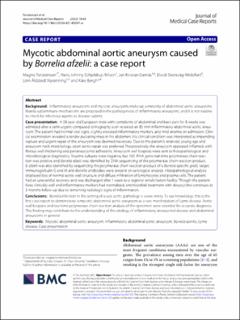| dc.contributor.author | Torsteinsen, Magne | |
| dc.contributor.author | Nilsen, Hans-Johnny | |
| dc.contributor.author | Damås, Jan Kristian | |
| dc.contributor.author | Stensvåg, Dordi | |
| dc.contributor.author | Nyrønning, Linn Ålstedt | |
| dc.contributor.author | Bergh, Kåre | |
| dc.date.accessioned | 2023-03-10T09:51:11Z | |
| dc.date.available | 2023-03-10T09:51:11Z | |
| dc.date.created | 2022-04-22T13:33:52Z | |
| dc.date.issued | 2022 | |
| dc.identifier.citation | Journal of Medical Case Reports. 2022, 16 (1), . | en_US |
| dc.identifier.issn | 1752-1947 | |
| dc.identifier.uri | https://hdl.handle.net/11250/3057625 | |
| dc.description.abstract | Background
Inflammatory aneurysms and mycotic aneurysms make up a minority of abdominal aortic aneurysms. Mainly autoimmune mechanisms are proposed in the pathogenesis of inflammatory aneurysms, and it is not routine to check for infectious agents as disease culprits.
Case presentation
A 58-year-old European male with complaints of abdominal and back pain for 8 weeks was admitted after a semi-urgent computed tomography scan revealed an 85 mm inflammatory abdominal aortic aneurysm. The patient had normal vital signs, slightly elevated inflammatory markers, and mild anemia on admission. Clinical examination revealed a tender pulsating mass in his abdomen. His clinical condition was interpreted as impending rupture and urgent repair of the aneurysm was deemed necessary. Due to the patient’s relatively young age and aneurysm neck morphology, open aortic repair was preferred. Preoperatively, the aneurysm appeared inflamed, with fibrous wall thickening and perianeurysmal adhesions. Aneurysm wall biopsies were sent to histopathological and microbiological diagnostics. Routine cultures were negative, but 16S rRNA gene real-time polymerase chain reaction was positive and Borrelia afzelii was identified by DNA sequencing of the polymerase chain reaction product. B. afzelii was also identified by sequencing the polymerase chain reaction product of a Borrelia-specific groEL target. Immunoglobulin G and M anti-Borrelia antibodies were present on serological analysis. Histopathological analysis displayed loss of normal aortic wall structure and diffuse infiltration of lymphocytes and plasma cells. The patient had an uneventful recovery and was discharged after 1 week to a regional rehabilitation facility. Though the patient fares clinically well and inflammatory markers had normalized, antimicrobial treatment with doxycycline continues at 3 months follow-up due to remaining radiologic signs of inflammation.
Conclusions
Borrelia infection in the setting of acute aortic pathology is a rare entity. To our knowledge, this is the first case report to demonstrate a mycotic abdominal aortic aneurysm as a rare manifestation of Lyme disease. Aortic wall biopsies and real-time polymerase chain reaction analysis of the specimen were essential for accurate diagnosis. This finding may contribute to the understanding of the etiology of inflammatory aneurysmal disease and abdominal aneurysms in general. | en_US |
| dc.language.iso | eng | en_US |
| dc.publisher | BioMed Central | en_US |
| dc.rights | Navngivelse 4.0 Internasjonal | * |
| dc.rights.uri | http://creativecommons.org/licenses/by/4.0/deed.no | * |
| dc.title | Mycotic abdominal aortic aneurysm caused by Borrelia afzelii: a case report | en_US |
| dc.title.alternative | Mycotic abdominal aortic aneurysm caused by Borrelia afzelii: a case report | en_US |
| dc.type | Peer reviewed | en_US |
| dc.type | Journal article | en_US |
| dc.description.version | publishedVersion | en_US |
| dc.source.volume | 16 | en_US |
| dc.source.journal | Journal of Medical Case Reports | en_US |
| dc.source.issue | 1 | en_US |
| dc.identifier.doi | 10.1186/s13256-021-03247-w | |
| dc.identifier.cristin | 2018435 | |
| cristin.ispublished | true | |
| cristin.fulltext | original | |
| cristin.qualitycode | 1 | |

